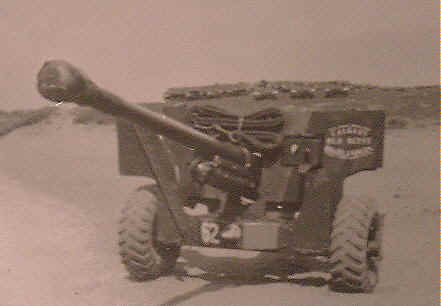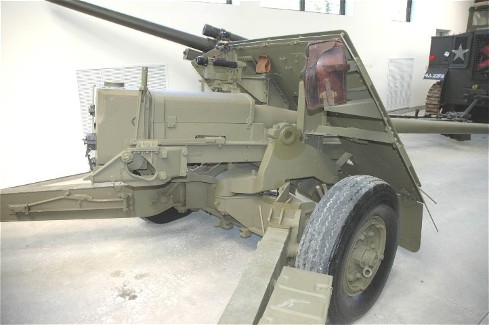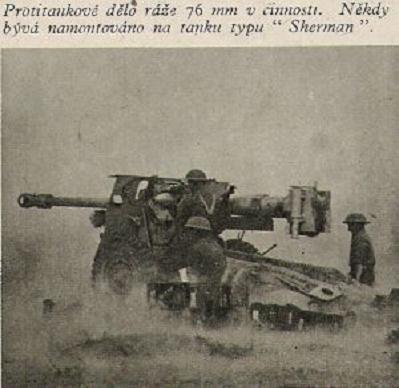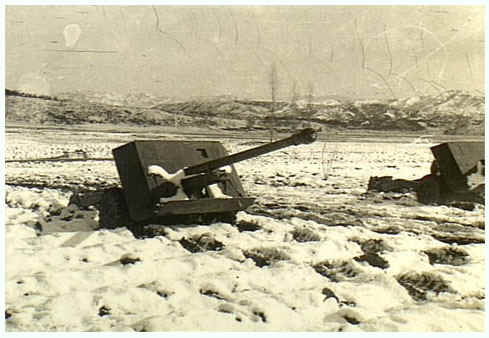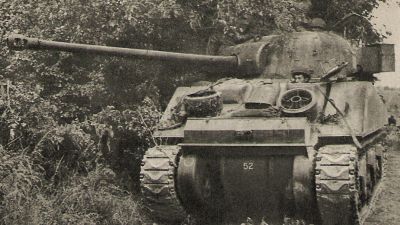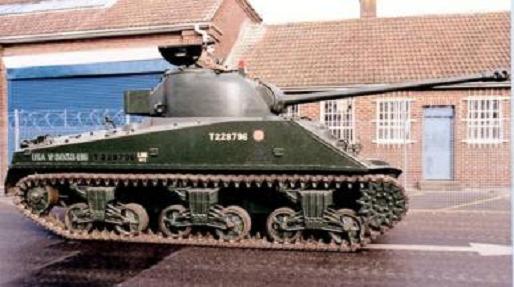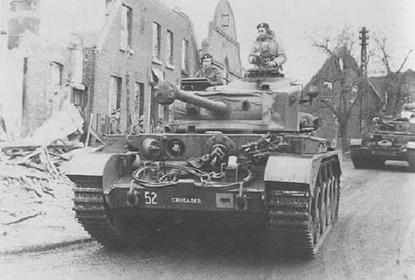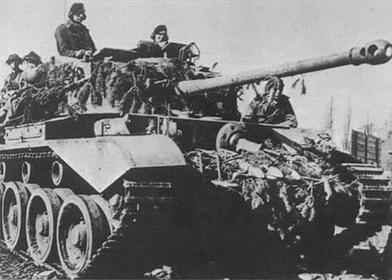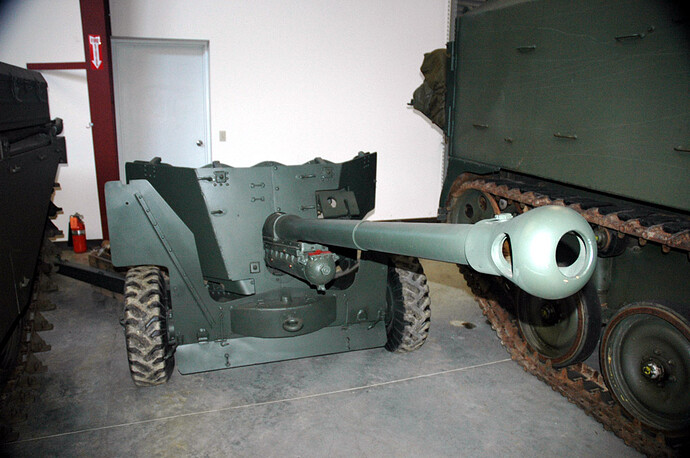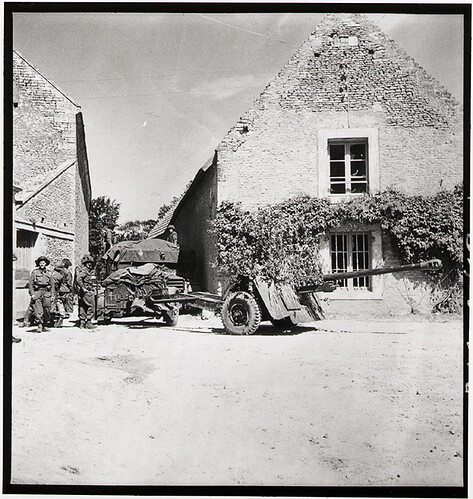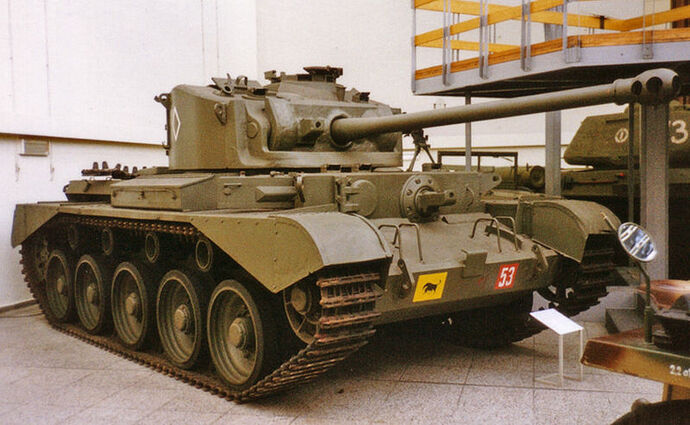I’m here to remind people that although all in all the German 88 was probably all in all the most succesfull gun. And the T-34 both in it’s 76mm and 85mm guns were the best tanks (because that there were about 50 000 of them all together, otherwize we could all just vote the Panther and King tiger, but the latter couldnt cross most bridges in Europe, and only under 200 were made, and from the 6000 Panthers made, they have figured that about 15 000 Stug IIIs, IV’s and Jagdpanzer IV’s, which sported the same L-70 75mm gun as th e Panther, could have been made! You make the math on which would have been a better defencive option).
And although the Russian 85mm gun was good, there was one that not only had the same tank killing power as the german ‘88’, but also was the father of all tank guns of today. How? It was the first gun to seriously fire SABOT rounds!
Yep, although sabot’s were experimented on on the good but not powerful enough 6pounder, and also some German contraption, the 17pounder had it’s secret in this munition.
I do not think that many here need to be explained what a SABOT round is, but for those who dont know here we go…
Usually in say a 100mm gun, the shell is also 100mm thick right? But in a SABOT, there is this outer shell, that is 100mm thick, but inside there is a say 60mm long thin pointed anti tank ‘needle’, made of a heavier metal, than what is usually used, in ww2 this was Tungsten, the strongest metal found in nature, nowadays they use Depleted Uranium, which is even more heavier, and doesnt loose the sharpness of it’s point on impact!
So, when the 100mm shell exits the gun barrel, it has four serrations in the frontal part of the ‘outer shell’, and it kind of ‘banana peels’, off instantly to let the smaller 60mm ‘dart’, of heavier metal, which has used the larger blast of the thicker barrel to get more speed behind it, but being a heavy and think projectile, it fly’s much straighter, and has the impact of a ‘normal’ anti tank 100mm shell, but impacting onto a 60mm area!
So, you get almost 50% more mass hitting an area almost 50% less, so penetration is much easier! Also it’s so strong, that the metal of the tank spalls more. Spalling is what is known as molten metal, of metal shards from the impact flying into the tank, usually causing horrible wounds to the crew, and often blowing up the tank by hitting internal ammunition stores…
The Brits in ww2 made shure also that the SABOT arrow wouldnt just go through neatly, so they made most of the ‘dart’, from normal metal, and put a kind of Tungsten condom if you will onto the end, meaning that once it penetrated, the tungsten end, would separate, and both the arrow and the loose tip would bounce about inside, meaning ofcourse the equivalent of two bullets bouncing inside but both had a hitting power of say, a 40mm shell!
This usually killed crew and also could blow up the ammo that the Germans crews often stored on the floor of the tanks, as they werent that regurlaly supplied after mid 1943, so they tried to get in as much shells as possible, as they didnt know when they would be supplied next…
So, why wasnt the 17pounder recognized as the most advanced tank killer?
Well, during ww2, the combat troops of Germany knew the danger of the 17pounder very well, so that when the Brit’s managed to get one into a Sherman by tilting it’s turret sideways, and then re- modelling it, they called this the Sherman Firefly.
German tank and AT crews would always go for the Firefly’s first. and the Brits would paint the part of the barrel that was longer than on the older Sherman, in a ligher colour, and sometimes it worked!
The US army made a great mistake in not going for the Firefly, but their own 76mm version, which was a dissapointment… If they would have been as easy going as the airforce guys, who had no problem in duplicating the Rolls Royce Merlin, with the Packard licence for the P-51, thus making one of the most succesfull and probably the most long ranged figher of ww2, the Mustang…
But the US Army was more founded in tradition, and couldnt abide the fact that the Brit’s had come up with the answer to the ‘88’.
And, although the Sherman was otherwize still pretty much a deathtrap, when the Brits put a 17pounder onto their new tank the Comet, they had finally came up with a tank about as good as the Panther, and better than the T-34/85. But it only really came onto the battlefields in 45, and that part of Germany, just didnt have much of any tanks defending it, so the Comets were basically dodging Panzerfaust anti tank rockets, and the final showdown to prove all those frustrating years when the Brits had inferior tanks would have been history!
Still, people forget that for a short period in 1940 to 1941 (before Russia’s T-34 became the new master of disaster along their KV-1), the Matilda II, was superior to any axis tank! They even called it the ‘Queen of the battlefield’ but the ‘88’ was always stalking, and the Matilda crews knew their day was over when the long 75mm ‘Panzer IV special’, appeared in 1942.
Still, in the desert, even the Six pounder which was the first gun of that design, and the 17pounder it’s follow up, the six pounder could easily make mush out of the main Africa Korps battle tank in 41 and 42, the Panzer III. So, you can imagine the shock when the 17pounders started to blast the German tanks from ranges one km away!
Nowadays all of the ‘NATO standard tanks’, meaning the Abrams (US ), Le Clerc(France), Leopard II (Germany), Challenger II (UK) and although not nato the Merkava (Israel), all use the 120mm (outer shell, the inner shell is a depleted uranium ‘dart’, about the thickness of a two Euro coin)! When it hit’s a tank, the kinetic equivalent is that of a long passanger train going at 100mph hitting the area the size of a two Euro coin! Now that’s a lot of power!!!
And infact the kinetic heat, heats up the metal of the surrounding area to such a degree that it glows red, so you can imagine that very often the ammunition and petrol in the tank just blow up from the heat alone, let alone the spalling…
And all this was already in use by the Brits during ww2!
I’ll post pics of the six pounder, and mostly the 17pounder and some tanks that had it… Remember, that military history is selective, and is constantly in need of new perspectives, which is more possible now that the cold war is history, and the idea that the US saved democracy is becoming outdated, the Europeans, lead by Britain, Russia, Yugoslavia, they did it, the US helped a lot shure, but the Europeans did it! Now the pacific is another kettle of fish, and I wont get into that, but that was the Chinese, and then the US who did the ‘coup de crace’ to the Japanese…
But even there, one must be reminded that the longest lasting and most manpower consuming large land battle that the Japanese fought agaisnt the allies was in Burma!
